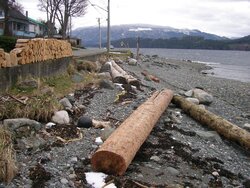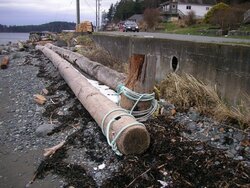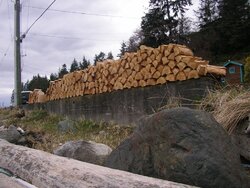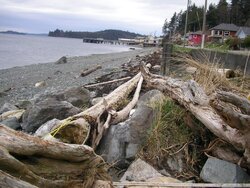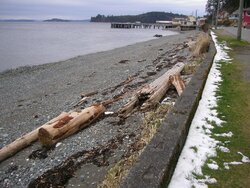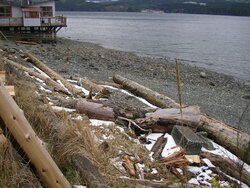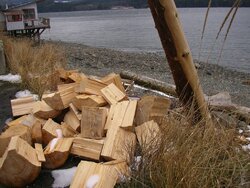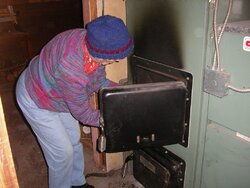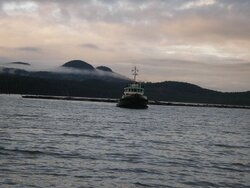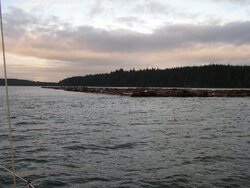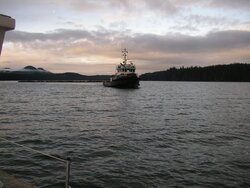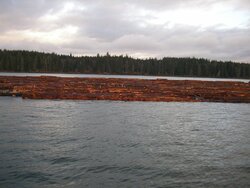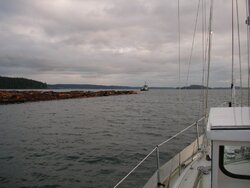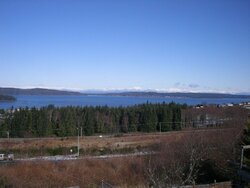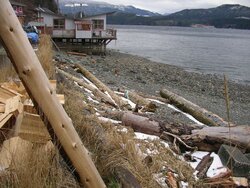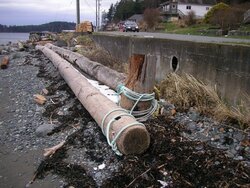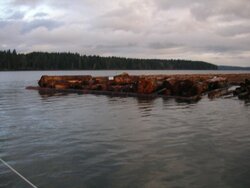Alert Bay is a small island community on the west coast of BC. What timber that is on the island is all privately owned. So the only way a lot of people get their firewood is to catch the logs as they drift by and tie the logs up until they feel like cutting them up. To the locals, a beachcombed log that is tied up with just the smallest of rope is sacred. To take someone's log that has been tied up would put you on the same level as a horse thief in the old west.
Beachcombing firewood Alert Bay, BC
- Thread starter hobbyheater
- Start date
-
Active since 1995, Hearth.com is THE place on the internet for free information and advice about wood stoves, pellet stoves and other energy saving equipment.
We strive to provide opinions, articles, discussions and history related to Hearth Products and in a more general sense, energy issues.
We promote the EFFICIENT, RESPONSIBLE, CLEAN and SAFE use of all fuels, whether renewable or fossil.
You are using an out of date browser. It may not display this or other websites correctly.
You should upgrade or use an alternative browser.
You should upgrade or use an alternative browser.
- Status
- Not open for further replies.
hobbyheater said:Alert Bay is a small island community on the west coast of BC. What timber that is on the island is all privately owned. So the only way a lot of people get their firewood is to catch the logs as they drift by and tie the logs up until they feel like cutting them up. To the locals, a beachcombed log that is tied up with just the smallest of rope is sacred. To take someone's log that has been tied up would put you on the same level as a horse thief in the old west.
Attachments
eclecticcottage
Minister of Fire
Hm. We use freshwater driftwood for kindling, but I thought the saltwater version was a no-no in wood stoves?
jimbom
Combustion Analyzer
Interesting post. Do they escape from log raft tows or come loose off of barges?
If you don't have a choice, then saltwater drift wood it is. Probably does corrode the steel/iron stoves.
Nice looking work, those. No limbs, bark, or forks to fool with.
If you don't have a choice, then saltwater drift wood it is. Probably does corrode the steel/iron stoves.
Nice looking work, those. No limbs, bark, or forks to fool with.
fishingpol
Minister of Fire
eclecticcottage said:Hm. We use freshwater driftwood for kindling, but I thought the saltwater version was a no-no in wood stoves?
Yes the salty wood is really hard on stoves. Grannie's wood /oil furnace has never burned beach wood and it is around 35 years old. There were several others like the one pictured that her husband installed for others but those burned beach wood and did not last much over 20 years. Most people in this town build masonry chimneys.
Attachments
jimbom said:Interesting post. Do they escape from log raft tows or come loose off of barges?
Most of the log towing between Vancouver Island and the mainland is still towed in bundle booms but tows break up if caught in rough water. Moving logs on barges is very expensive. There are three major booming grounds in the area where they make up the bundle booms and most of the logs get loose from those operations.
Couple pictures of a log tow .
Attachments
Oregon Bigfoot
Feeling the Heat
Nice pictures, and gorgeous area! Thanks for sharing.
Reminds me a LOT of Whidbey Island in Puget Sound. We have vacationed on Whidbey Island many times. Pretty soon, the Japanese Tsunami will wash up some wood and a lot of other stuff for the beach combers. I've heard some Tsunami stuff has already arrived to the western portion of Vancouver Island, and also to the Washington State coast.
Reminds me a LOT of Whidbey Island in Puget Sound. We have vacationed on Whidbey Island many times. Pretty soon, the Japanese Tsunami will wash up some wood and a lot of other stuff for the beach combers. I've heard some Tsunami stuff has already arrived to the western portion of Vancouver Island, and also to the Washington State coast.
fishingpol said:Nice pictures again Allan. Thanks for sharing.
There is another small island community called Sointula where you will also see logs tied up along the beach in the same fashion. It is just something a little different so I'm happy that you enjoyed the pictures .
The community of Sointula is pictured across the water .
Attachments
Oregon Bigfoot said:Nice pictures, and gorgeous area! Thanks for sharing.
This picture, if you enlarge it, it looks like a spider's web with various types of rope.
Attachments
DanCorcoran
Minister of Fire
I was stationed at the Naval Air Station on Whidbey Island in 1969-1972. There were many such logs washed up on the beach at the time, but I don't know that they were scrounged for firewood back then. I do remember collecting some of the huge chains that linked the logs together (the ones that formed the outside ring around the log tows). They were 6-8 feet long and had a ring on one end and a spike on the other, so they could be linked end to end, with the spike passed through the hole in the end of the log. That is a really beautiful region.
DanCorcoran said:I was stationed at the Naval Air Station on Whidbey Island in 1969-1972. There were many such logs washed up on the beach at the time, but I don't know that they were scrounged for firewood back then. I do remember collecting some of the huge chains that linked the logs together (the ones that formed the outside ring around the log tows). They were 6-8 feet long and had a ring on one end and a spike on the other, so they could be linked end to end, with the spike passed through the hole in the end of the log. That is a really beautiful region.
The huge chains are know as boom-chains. The pointed end is called a "toggle" and it can pass through the large ring to make the connection, or when the toggle is crossed, it will not pass through the hole drilled in the the boom stick. These are the logs that go around the outside of the boom. Several municipalities have banned the cutting of logs on the beaches for firewood as they say the logs prevent erosion, but I'm suspect that it has more to do with noise.
Pictured, these are boom sticks - you can see the round hole in the end of one log that these chains go through. The boom stick would be 66' log and 24" to 36" in diameter at the butt. Fuzzy picture of the boomstick at the back of the boom gives a ideal of what they do.
Attachments
- Status
- Not open for further replies.
Similar threads
- Replies
- 0
- Views
- 2K


